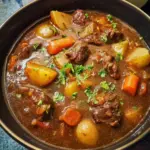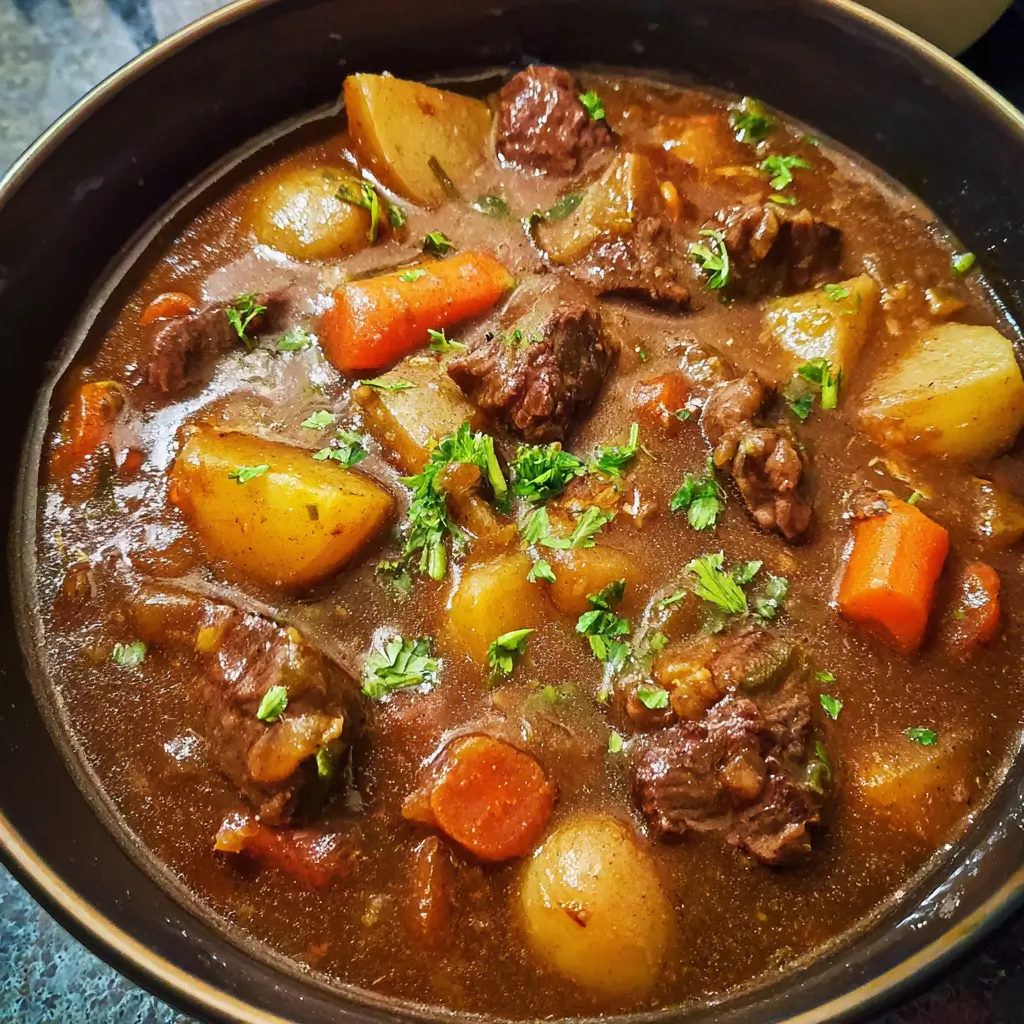The rich, savory aroma of beef stew simmering on the stove promises comfort in every spoonful. This hearty, soul-warming dish transforms humble ingredients into a magnificent meal through the magic of slow cooking. Tender chunks of beef mingle with earthy vegetables in a deeply flavored broth that’s been developing for hours. You’ll learn how to create a beef stew that’s not just a recipe but a culinary hug – perfect for cold evenings or whenever you need something substantial and satisfying.
Why You’ll Love This Recipe
This classic beef stew recipe delivers extraordinary flavor with minimal effort, making it perfect for both weeknight dinners and special occasions. The slow cooking process transforms tough cuts of beef into morsels so tender they practically melt in your mouth, while the vegetables absorb all the savory goodness of the broth. You’ll appreciate the beautiful contrast between the silky, rich sauce and the hearty chunks of meat and vegetables.
What makes this beef stew truly special is its versatility and depth of flavor. The combination of herbs, wine, and broth creates layers of taste that continue to develop as the stew cooks. Even better, this dish improves with time, making leftovers something to look forward to. Whether you’re an experienced cook or a beginner in the kitchen, this foolproof recipe delivers consistently delicious results that will have everyone asking for seconds.
Ingredients
For this classic beef stew, you’ll need:
- 2 pounds (900g) beef chuck, cut into 1-inch cubes
- 3 tablespoons (45ml) vegetable oil, divided
- 2 tablespoons (16g) all-purpose flour
- 1 large onion (about 1 cup/160g), chopped
- 3 garlic cloves, minced
- 2 tablespoons (30g) tomato paste
- 1 cup (240ml) dry red wine (or additional beef broth)
- 4 cups (960ml) beef broth
- 2 bay leaves
- 1 teaspoon dried thyme
- 3 large carrots (about 1½ cups/195g), cut into chunks
- 2 stalks celery (about ¾ cup/90g), sliced
- 1 pound (450g) baby potatoes, halved
- 1 cup (150g) frozen peas
- Salt and freshly ground black pepper, to taste
- 2 tablespoons fresh parsley, chopped (for garnish)
The beef chuck is crucial as it contains enough fat and connective tissue to become tender and flavorful during slow cooking. The combination of wine and beef broth creates a rich base, while the herbs infuse the stew with aromatic notes that complement the savory meat perfectly.
Pro Tips
Season and Sear Properly: The secret to exceptional beef stew starts with properly seasoning and searing the meat. Pat the beef cubes completely dry with paper towels before seasoning generously with salt and pepper. Sear in small batches (overcrowding causes steaming instead of browning) until deeply browned on all sides. This step creates the foundation of flavor through the Maillard reaction, developing those complex, caramelized notes that make your stew extraordinary.
Deglaze and Scrape: After sautéing your aromatics, deglaze the pot with wine or broth, using a wooden spoon to scrape up every bit of the browned bits (fond) from the bottom. These concentrated flavor particles contain incredible depth and richness that will transform your stew’s base. Taking an extra minute for proper deglazing makes the difference between a good stew and an outstanding one.
Master the Simmer: The perfect beef stew requires patience and gentle heat. Maintain a low, steady simmer throughout cooking—never a rolling boil, which toughens meat fibers. Look for occasional small bubbles breaking the surface. Add root vegetables like carrots and potatoes in the last hour of cooking to prevent them from becoming mushy, while adding delicate vegetables like peas in the final minutes preserves their vibrant color and texture.
Instructions
Step 1: Prepare the Beef
Pat the beef chunks completely dry with paper towels – this ensures proper browning. Season generously with salt and freshly ground black pepper, then toss with flour until lightly coated. Heat 2 tablespoons of oil in a large Dutch oven or heavy-bottomed pot over medium-high heat until shimmering. Working in batches (about 3-4), sear the beef for 2-3 minutes per side until deeply browned. Don’t rush this step – it’s where you build incredible flavor! Transfer the browned meat to a plate and continue until all beef is seared.
Step 2: Sauté the Aromatics
Reduce heat to medium and add the remaining tablespoon of oil to the pot. Add the chopped onions and cook for 4-5 minutes until softened and translucent. Add the minced garlic and cook for another 30 seconds until fragrant, being careful not to burn it. Stir in the tomato paste and cook for 1-2 minutes, allowing it to caramelize slightly, which deepens the flavor profile of your beef stew.
Step 3: Deglaze and Build the Base
Pour in the red wine (or additional broth if preferred) and scrape the bottom of the pot vigorously with a wooden spoon to release all those flavorful browned bits. Let the liquid simmer for 2-3 minutes, reducing slightly. Return the beef to the pot along with any accumulated juices – these contain concentrated flavor! Add the beef broth, bay leaves, and dried thyme. Bring the mixture to a gentle boil, then reduce heat to maintain a low simmer.
Step 4: Slow Cook to Perfection
Cover the pot and simmer gently for 1.5 hours, occasionally checking to ensure it’s not boiling too vigorously. The beef should be starting to become tender at this point. Add the carrots, celery, and potatoes, then continue to simmer covered for another 30-45 minutes until the vegetables and beef are fork-tender. The sauce should be rich and slightly thickened. If it’s too thin, you can simmer uncovered for 10-15 minutes to reduce.
Step 5: Finish and Serve
About 5 minutes before serving, stir in the frozen peas – they’ll cook quickly in the hot stew. Taste and adjust seasoning with additional salt and pepper as needed. Remove the bay leaves, ladle the beef stew into bowls, and garnish with freshly chopped parsley. Serve with crusty bread to soak up every last drop of the flavorful sauce.
Variations
Wine Country Beef Stew: Elevate your beef stew with a French twist by using Burgundy wine instead of regular red wine. Add 8 ounces of quartered mushrooms when sautéing the onions and include 1 teaspoon of herbs de Provence with the other herbs. For an authentic touch, replace standard potatoes with small pearl onions (about 1 cup) added in the last 30 minutes of cooking. This variation creates a more sophisticated flavor profile reminiscent of Beef Bourguignon.
Hearty Irish Beef and Guinness Stew: For a robust Irish-inspired variation, substitute the red wine with 1 cup of Guinness stout. The dark beer adds a distinctive malty sweetness and depth. Include 1 tablespoon of brown sugar and 1 tablespoon of Worcestershire sauce when adding the liquids. Increase the potatoes to 1.5 pounds and add 1 small turnip, cubed. This heartier version pairs beautifully with Irish soda bread and delivers authentic pub-style comfort.
Mediterranean Beef Stew: Create a sun-kissed variation by adding 1 diced red bell pepper with the onions, using rosemary instead of thyme, and incorporating 1 can (14 oz) of diced tomatoes with the broth. About 20 minutes before serving, stir in 1 cup of pitted kalamata olives and a handful of chopped fresh basil. This lighter beef stew version brings brightness to the traditional recipe and works wonderfully served over polenta or with a crusty ciabatta.
Storage and Serving
Beef stew is one of those magical dishes that actually improves with time as the flavors continue to meld. To store properly, cool the stew completely before transferring to airtight containers. Refrigerate for up to 4 days, or freeze for up to 3 months. When reheating, thaw overnight in the refrigerator if frozen, then warm gently on the stovetop over medium-low heat, adding a splash of broth if needed to reach desired consistency. Avoid boiling as this can toughen the meat.
For serving, pair your beef stew with crusty artisan bread or warm dinner rolls for soaking up the rich sauce. For a complete meal, serve over creamy mashed potatoes, buttered egg noodles, or fluffy white rice. A simple side salad with a light vinaigrette provides a refreshing contrast to the stew’s richness. For an elevated presentation, serve in hollowed-out bread bowls, garnished with a sprig of fresh thyme and a drizzle of good olive oil.
FAQs
What’s the best cut of beef for beef stew?
Chuck roast is ideal for beef stew because it has excellent marbling and connective tissue that breaks down during slow cooking, resulting in tender, flavorful meat. Other good options include bottom round, rump roast, or brisket. Avoid leaner cuts like sirloin which can become tough and dry.
Can I make beef stew in a slow cooker?
Absolutely! Brown the meat and sauté aromatics as directed, then transfer everything to a slow cooker. Cook on low for 7-8 hours or high for 4-5 hours, adding the vegetables during the last 1-2 hours of cooking time. The slow cooker makes beef stew even more convenient for busy days.
Why is my beef stew meat tough?
Tough meat usually results from insufficient cooking time or cooking at too high a temperature. Beef stew needs gentle, slow simmering to break down connective tissues. If meat is still tough, continue cooking at a low simmer for another 30-45 minutes, checking periodically for tenderness.
How can I thicken my beef stew?
If your beef stew is too thin, make a slurry by mixing 1 tablespoon cornstarch with 2 tablespoons cold water, then stir into the simmering stew. Alternatively, you can remove 1 cup of cooked potatoes, mash them, and stir back into the stew for natural thickening.
Can I make beef stew ahead of time for a dinner party?
Yes, beef stew is perfect for making ahead! Prepare it 1-2 days in advance, refrigerate, then reheat gently before serving. The flavors actually improve with time, making it an excellent choice for entertaining without last-minute cooking stress.
Conclusion
This beef stew is comfort food at its finest — a hearty, soul-satisfying dish that transforms humble ingredients into something truly spectacular through the magic of slow cooking. It’s the kind of dish that fills your home with mouthwatering aromas and brings everyone to the table with eager anticipation. Whether you’re serving it on a chilly winter evening, preparing a special family dinner, or simply craving something deeply satisfying, this classic recipe delivers consistent, delicious results every time. Master this beef stew, and you’ll have a timeless culinary treasure in your recipe collection that will bring comfort and joy for years to come.
Print
How to Make Beef Stew
Description
The ultimate one-pot comfort food that’s worth every minute of simmering – this beef stew recipe turns an affordable cut of meat into the most satisfying meal you’ll make all season.
Ingredients
- 2 pounds beef chuck, cut into 1-inch cubes
- 3 tablespoons vegetable oil, divided
- 2 tablespoons all-purpose flour
- 1 large onion, chopped
- 3 garlic cloves, minced
- 2 tablespoons tomato paste
- 1 cup dry red wine (or additional beef broth)
- 4 cups beef broth
- 2 bay leaves
- 1 teaspoon dried thyme
- 3 large carrots, cut into chunks
- 2 stalks celery, sliced
- 1 pound baby potatoes, halved
- 1 cup frozen peas
- Salt and freshly ground black pepper, to taste
- 2 tablespoons fresh parsley, chopped (for garnish)
Instructions
- Pat beef dry with paper towels. Season with salt and pepper, then toss with flour until lightly coated.
- Heat 2 tablespoons oil in a Dutch oven over medium-high heat. Working in batches, sear beef for 2-3 minutes per side until browned. Transfer to a plate.
- Add remaining oil to pot. Sauté onions for 4-5 minutes until softened. Add garlic and cook 30 seconds. Stir in tomato paste and cook 1-2 minutes.
- Pour in wine, scraping up browned bits from bottom of pot. Simmer 2-3 minutes.
- Return beef to pot. Add beef broth, bay leaves, and thyme. Bring to gentle boil, then reduce heat to low. Cover and simmer for 1.5 hours.
- Add carrots, celery, and potatoes. Continue simmering covered for 30-45 minutes until vegetables and beef are tender.
- Stir in frozen peas 5 minutes before serving. Taste and adjust seasoning.
- Remove bay leaves, ladle into bowls, and garnish with parsley.








